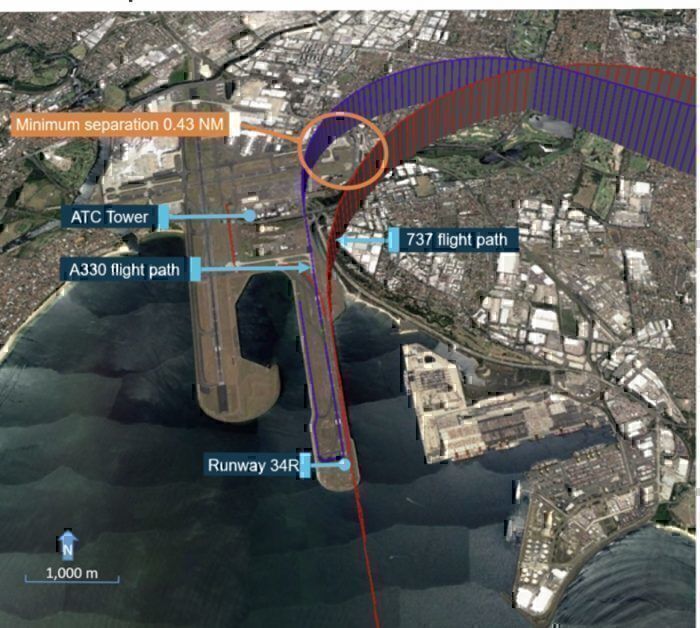The Australian Transport Safety Bureau (ATSB) yesterday released its preliminary report into a loss of separation incident involving two Qantas aircraft at Sydney Airport last year. The incident was classed as serious - the two aircraft came within 796 metres laterally and 152 metres vertically of each other.
Diving into the details
The incident occurred on the 5th of August 2019 and was reported in Simple Flying. A Qantas A330-200 (VH-EBJ) was departing for Perth and cleared for takeoff on runway 34R. At the same time, a Qantas 737-800 (VH-VZO) en route from Brisbane was coming in to land on the same runway.
A trainee air traffic controller was managing the flights under the supervision of an on-the-job instructor. The trainee controller realized there was not enough runway spacing between the two aircraft and told the 737-800 to go-around. It was when the 737-800 missed the approach that the loss of separation incident occurred.
When the A330-200 initially lined up to depart, it was delayed slightly waiting for a turboprop aircraft to clear the runway. The 737-800 was instructed to maintain minimum speed which it was already doing. Approximately forty seconds after lining up on 34R, the A330-200 was rolling for take-off. At this point, the trainee controller judged the minimum separation threshold would not be maintained and ordered the go-around.
Within thirty seconds the A330-200 was airborne on runway track (335°). However, the 737-800 was on the same track and now climbing through 920 feet (having descended to 400 feet). The 737-800 pilots were instructed to turn right onto heading 100°. The A330-200 was also turning right tracking on the MARUB 6 standard instrument departure.
The A330-200 then received an ACAS traffic advisory alert (TRAFFIC TRAFFIC) and sighted the 737-800 closeby above in a climbing turn. The 737-800 was instructed to turn further right onto heading 120° and climb to 3000 feet. The A330-200 was instructed to turn left heading 100° and the aircraft safely separated and diverged.
The time elapsed between the A330-200 lining up on 34R to depart and the two aircraft safely diverging when airborne was 81 seconds.
What the preliminary ATSB report found
The separation incident occurred in the early evening and it was just dark. While the ATSB preliminary report noted the air traffic trainee was experienced, having previously worked in another tower and possessing a surface movement controller rating at Sydney, the ATSB found the trainee controller issued a nighttime radar vector to the 737-800 when the aircraft was below the minimum vector altitude. Terrain separation was not maintained.
When aircraft are flying inside terminal area airspace (like around Sydney), air traffic controllers must maintain a minimum separation between aircraft of three nautical miles laterally and 1,000 feet vertically. This can be reduced by air traffic control when using visual separation. Both the air traffic controller and the supervisor said they had the two aircraft sighted and were applying visual separation.
When a loss of separation incident occurs, the air traffic controller is required to issue safety alerts to involved aircraft as a priority. But in this case, neither the trainee controller nor his supervisor issued an alert as both believed visual separation existed.
In a statement yesterday, the ATSB’s director of transport safety Stuart Godley said;
“Preliminary reports outline basic factual information established in the early phase of an investigation. They do not contain findings, identify contributing factors or outline safety issues and actions, which will be detailed in an investigation’s final report.”
When the incident occurred, Qantas noted that its crews on both aircraft followed air traffic control instructions at all times and they stand good and ready to assist the ATSB investigation. Following the separation incident, both flights landed safely at their respective destinations.
The ATSB investigation is continuing and will include looking at controller training, air traffic control procedures and instrument departure systems. A final report is due later in 2020.



